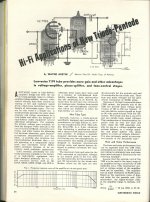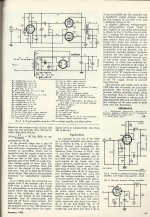The WA-44C manual I found online is dated 1960 - old enough that I'd expect to find leaky paper dielectric capacitors in addition to the electrolytics which are well past their design life. But I'd expect the tubes to be fine - I wouldn't even test them unless there was a problem after changing the capacitors. And I have 6U8s, 6AQ5, 6X4 in quantity...
Thank you. Others have also noted that my main concern should be caps, so I will check them out.
So now, apparently I should be looking for a good source for good caps rather than tubes!
So now, apparently I should be looking for a good source for good caps rather than tubes!
So now, apparently I should be looking for a good source for good caps rather than tubes!
That's no more difficult than your original question.😉
jeff
Mouser and Digi-Key are two popular online parts suppliers. They carry most any passive component you might need.So now, apparently I should be looking for a good source for good caps rather than tubes!
Electronic Components Distributor - Mouser Electronics
DigiKey Electronics - Electronic Components Distributor
6U8 $5
6GH8 $3
7687 $25 (an upgraded 7199) But still not any more linear than 7199.
6M to 11Y9
From looking at the datasheet for 7199, one should look for a better tube altogether, what a piece of non-linear junk, obviously made for cheap phono players.
6GH8 looks better.
Try a 6F12P for very high performance. (some bias changes needed and more limited voltages)
6GH8 $3
7687 $25 (an upgraded 7199) But still not any more linear than 7199.
6M to 11Y9
From looking at the datasheet for 7199, one should look for a better tube altogether, what a piece of non-linear junk, obviously made for cheap phono players.
6GH8 looks better.
Try a 6F12P for very high performance. (some bias changes needed and more limited voltages)
Last edited:
In my experience going NOS (if possible) is preferable in the sense that original tubes tend to have less tendency to fail, last longer, and adhere to the strict standards that "were" the mainstay of the "tube era".
Of course, and you'll often find, that NOS is substantially higher cost in some cases.
Supply and demand also factor into the mix, and the rarer the tube is, the higher priced it is.
As was mentioned previously, tubes, NOS, do not "go bad" from sitting in their boxes - as long as they're not damaged.
A bit of oxidation on the pins can be removed, so not an issue.
Testing any tube before use is always a good idea, and if you're into tube stuff, you should have a decent tester, if only to check for shorts or emission quality.
I've done restorations of "vintage/antique" customer radios going back to the 1920's/1930's, and surprisingly, a lot of those old tubes held up well!
Of course, the bottom line is that any tube's life is dependent on its operating conditions - and those are the components UNDER the chassis.
As for "new manufacture" tubes, the quality is all over the map in some cases.
As a long time servicer, I've seen plenty of issues with some new tubes, not all.
This compared with NOS of course, where the issues are less in my opinion.
I have to disagree on the reliability of NOS tubes. If you buy new production tubes that have been "burned in", there will very rarely be problems. As a contrast, I've had a lot of issues with NOS tubes. They CAN go bad just sitting on a shelf in that they become gassy, or they can get knocked around in who knows how many shop moves before they got to you.
I've dealt with a fair number of tubes that are known with a high level of certainty to be NOS (that is, they were spares for something that was decommissioned), and I've had fewer issues with used tubes than with new ones*.
With small signal tubes, the problems tend to be microphonics from being knocked around for 70 years, or because they were the rejects from a hand-picking operation.
With power tubes, the problem is usually gas from sitting for a really long time. That means they are prone to arcing. The 1625 (basically an 807 with a 12V filament) is rated for 750 V on the plate IIRC. A lot of NOS 1625s will arc over at 400 V. Note that a silver getter spot does necessarily mean that the tube has a clean vacuum. Note that breakdown voltage vs. pressure is not a linear relationship- look up Paschen's law if you want to learn more about this.
Running the filament for 24 hours on NOS tubes will help a lot with the gas issue, but it won't do much if they're really bad.
And as mentioned, the tubes in your audio generator are probably just fine. In most applications, small signal tubes last a ridiculously long time. In fact, tubes in general tend to last a really long time if they aren't abused, much longer than a lot of people think.
*The exception being tubes like the 250TH or the 4-125A. The filaments in these tubes get very fragile on high-hour units
Last edited:
Using a DC power source for the heater should fix the hum issue for most input tubes. Higher gm leads to lower internal tube noise, so a high gm pentode (6F12P, 7788, 7722, 7721, 6JC6, 5/6JK6) should be quietest. (microphonics could be an issue with high gm however) The 7199 linearity is rescued by the small signal level coming into the pentode typically.
One interesting possibility to eliminate microphonics would be to use a dual identical pentode (in one bottle like 6BN11, 6J11, 8CB11) where each identical tube section would have identical resonances (testing required obviously) and a differential gain stage would cancel those out electrically. Differences in lead in wiring could mess up the identical resonances. 8CB11 and 6J11 are similar dual pentodes with different pin-outs. Dual triodes (fewer elements to shake) might have better luck getting cancellation.
One interesting possibility to eliminate microphonics would be to use a dual identical pentode (in one bottle like 6BN11, 6J11, 8CB11) where each identical tube section would have identical resonances (testing required obviously) and a differential gain stage would cancel those out electrically. Differences in lead in wiring could mess up the identical resonances. 8CB11 and 6J11 are similar dual pentodes with different pin-outs. Dual triodes (fewer elements to shake) might have better luck getting cancellation.
Last edited:
- Home
- Amplifiers
- Tubes / Valves
- Where to buy tubes?

